Infrastructure for Innovation Hubs | Report
VerifiedAdded on 2022/08/17
|11
|3903
|10
AI Summary
Contribute Materials
Your contribution can guide someone’s learning journey. Share your
documents today.

TE
R
M
PA
PE
R
Infr
ast
ruc
tur
e
for
Inn
ova
tio
n
R
M
PA
PE
R
Infr
ast
ruc
tur
e
for
Inn
ova
tio
n
Secure Best Marks with AI Grader
Need help grading? Try our AI Grader for instant feedback on your assignments.
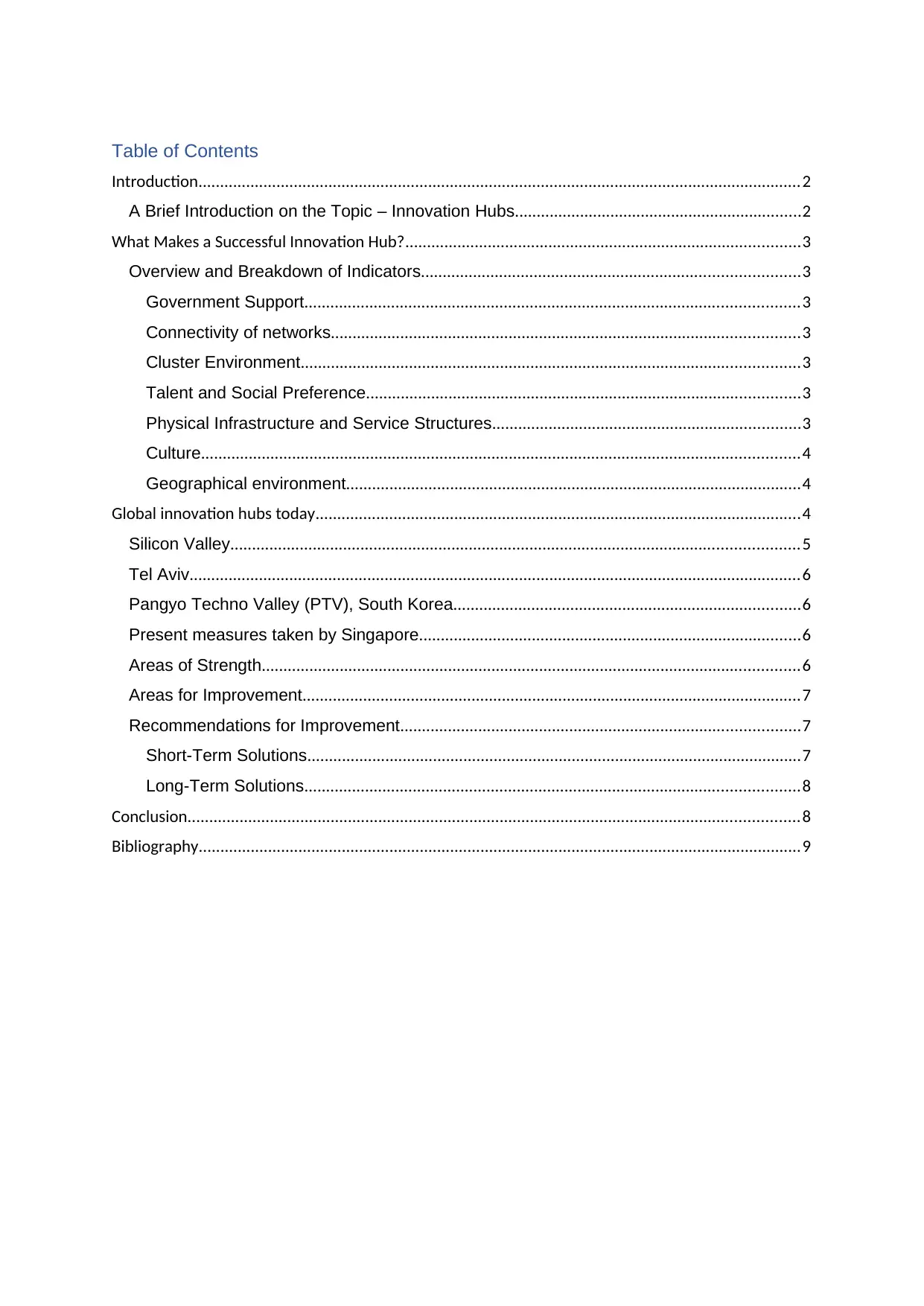
Table of Contents
Introduction...........................................................................................................................................2
A Brief Introduction on the Topic – Innovation Hubs..................................................................2
What Makes a Successful Innovation Hub?...........................................................................................3
Overview and Breakdown of Indicators.......................................................................................3
Government Support..................................................................................................................3
Connectivity of networks............................................................................................................3
Cluster Environment...................................................................................................................3
Talent and Social Preference....................................................................................................3
Physical Infrastructure and Service Structures.......................................................................3
Culture..........................................................................................................................................4
Geographical environment.........................................................................................................4
Global innovation hubs today................................................................................................................4
Silicon Valley...................................................................................................................................5
Tel Aviv.............................................................................................................................................6
Pangyo Techno Valley (PTV), South Korea................................................................................6
Present measures taken by Singapore........................................................................................6
Areas of Strength............................................................................................................................6
Areas for Improvement...................................................................................................................7
Recommendations for Improvement............................................................................................7
Short-Term Solutions..................................................................................................................7
Long-Term Solutions..................................................................................................................8
Conclusion.............................................................................................................................................8
Bibliography...........................................................................................................................................9
Introduction...........................................................................................................................................2
A Brief Introduction on the Topic – Innovation Hubs..................................................................2
What Makes a Successful Innovation Hub?...........................................................................................3
Overview and Breakdown of Indicators.......................................................................................3
Government Support..................................................................................................................3
Connectivity of networks............................................................................................................3
Cluster Environment...................................................................................................................3
Talent and Social Preference....................................................................................................3
Physical Infrastructure and Service Structures.......................................................................3
Culture..........................................................................................................................................4
Geographical environment.........................................................................................................4
Global innovation hubs today................................................................................................................4
Silicon Valley...................................................................................................................................5
Tel Aviv.............................................................................................................................................6
Pangyo Techno Valley (PTV), South Korea................................................................................6
Present measures taken by Singapore........................................................................................6
Areas of Strength............................................................................................................................6
Areas for Improvement...................................................................................................................7
Recommendations for Improvement............................................................................................7
Short-Term Solutions..................................................................................................................7
Long-Term Solutions..................................................................................................................8
Conclusion.............................................................................................................................................8
Bibliography...........................................................................................................................................9
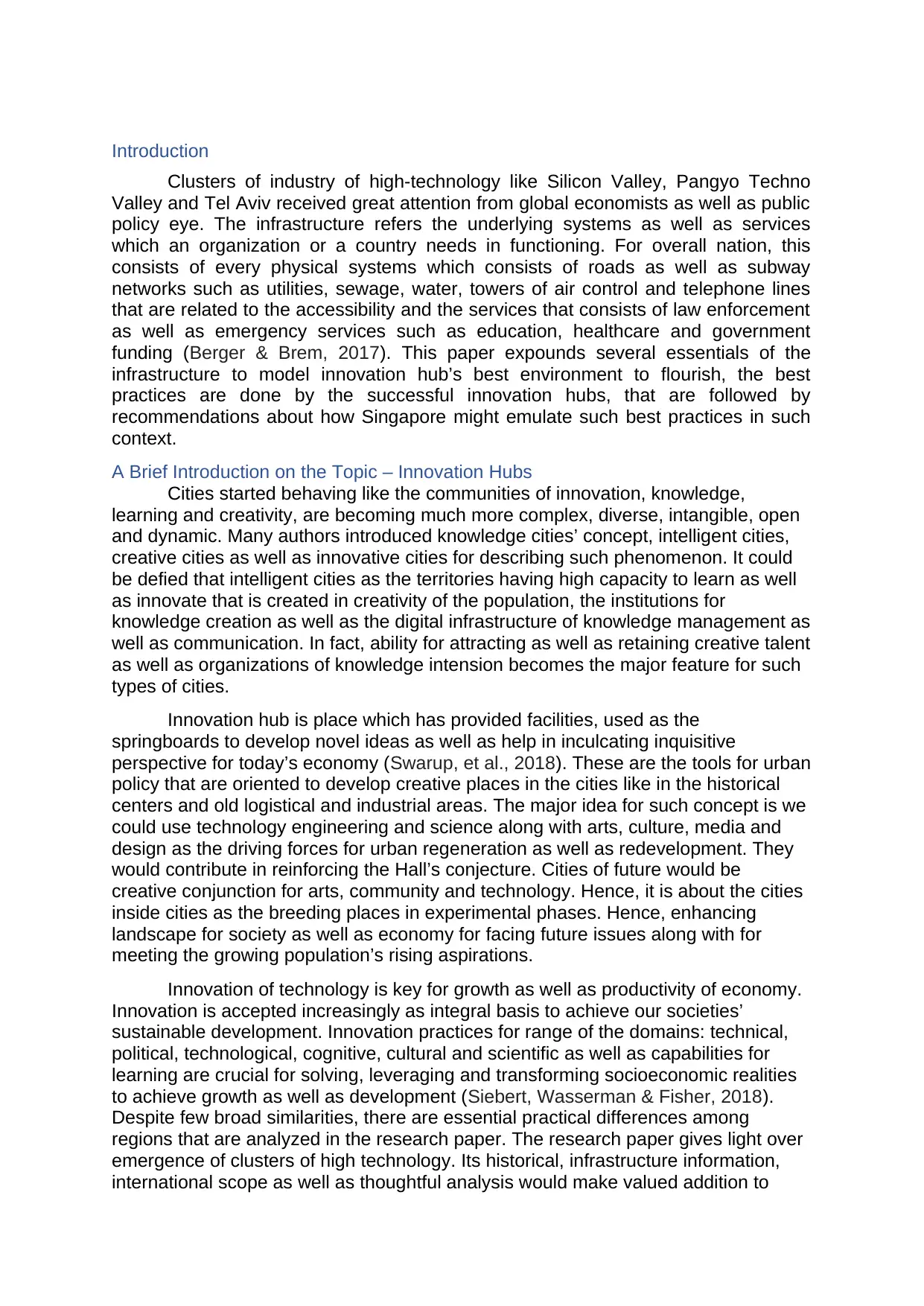
Introduction
Clusters of industry of high-technology like Silicon Valley, Pangyo Techno
Valley and Tel Aviv received great attention from global economists as well as public
policy eye. The infrastructure refers the underlying systems as well as services
which an organization or a country needs in functioning. For overall nation, this
consists of every physical systems which consists of roads as well as subway
networks such as utilities, sewage, water, towers of air control and telephone lines
that are related to the accessibility and the services that consists of law enforcement
as well as emergency services such as education, healthcare and government
funding (Berger & Brem, 2017). This paper expounds several essentials of the
infrastructure to model innovation hub’s best environment to flourish, the best
practices are done by the successful innovation hubs, that are followed by
recommendations about how Singapore might emulate such best practices in such
context.
A Brief Introduction on the Topic – Innovation Hubs
Cities started behaving like the communities of innovation, knowledge,
learning and creativity, are becoming much more complex, diverse, intangible, open
and dynamic. Many authors introduced knowledge cities’ concept, intelligent cities,
creative cities as well as innovative cities for describing such phenomenon. It could
be defied that intelligent cities as the territories having high capacity to learn as well
as innovate that is created in creativity of the population, the institutions for
knowledge creation as well as the digital infrastructure of knowledge management as
well as communication. In fact, ability for attracting as well as retaining creative talent
as well as organizations of knowledge intension becomes the major feature for such
types of cities.
Innovation hub is place which has provided facilities, used as the
springboards to develop novel ideas as well as help in inculcating inquisitive
perspective for today’s economy (Swarup, et al., 2018). These are the tools for urban
policy that are oriented to develop creative places in the cities like in the historical
centers and old logistical and industrial areas. The major idea for such concept is we
could use technology engineering and science along with arts, culture, media and
design as the driving forces for urban regeneration as well as redevelopment. They
would contribute in reinforcing the Hall’s conjecture. Cities of future would be
creative conjunction for arts, community and technology. Hence, it is about the cities
inside cities as the breeding places in experimental phases. Hence, enhancing
landscape for society as well as economy for facing future issues along with for
meeting the growing population’s rising aspirations.
Innovation of technology is key for growth as well as productivity of economy.
Innovation is accepted increasingly as integral basis to achieve our societies’
sustainable development. Innovation practices for range of the domains: technical,
political, technological, cognitive, cultural and scientific as well as capabilities for
learning are crucial for solving, leveraging and transforming socioeconomic realities
to achieve growth as well as development (Siebert, Wasserman & Fisher, 2018).
Despite few broad similarities, there are essential practical differences among
regions that are analyzed in the research paper. The research paper gives light over
emergence of clusters of high technology. Its historical, infrastructure information,
international scope as well as thoughtful analysis would make valued addition to
Clusters of industry of high-technology like Silicon Valley, Pangyo Techno
Valley and Tel Aviv received great attention from global economists as well as public
policy eye. The infrastructure refers the underlying systems as well as services
which an organization or a country needs in functioning. For overall nation, this
consists of every physical systems which consists of roads as well as subway
networks such as utilities, sewage, water, towers of air control and telephone lines
that are related to the accessibility and the services that consists of law enforcement
as well as emergency services such as education, healthcare and government
funding (Berger & Brem, 2017). This paper expounds several essentials of the
infrastructure to model innovation hub’s best environment to flourish, the best
practices are done by the successful innovation hubs, that are followed by
recommendations about how Singapore might emulate such best practices in such
context.
A Brief Introduction on the Topic – Innovation Hubs
Cities started behaving like the communities of innovation, knowledge,
learning and creativity, are becoming much more complex, diverse, intangible, open
and dynamic. Many authors introduced knowledge cities’ concept, intelligent cities,
creative cities as well as innovative cities for describing such phenomenon. It could
be defied that intelligent cities as the territories having high capacity to learn as well
as innovate that is created in creativity of the population, the institutions for
knowledge creation as well as the digital infrastructure of knowledge management as
well as communication. In fact, ability for attracting as well as retaining creative talent
as well as organizations of knowledge intension becomes the major feature for such
types of cities.
Innovation hub is place which has provided facilities, used as the
springboards to develop novel ideas as well as help in inculcating inquisitive
perspective for today’s economy (Swarup, et al., 2018). These are the tools for urban
policy that are oriented to develop creative places in the cities like in the historical
centers and old logistical and industrial areas. The major idea for such concept is we
could use technology engineering and science along with arts, culture, media and
design as the driving forces for urban regeneration as well as redevelopment. They
would contribute in reinforcing the Hall’s conjecture. Cities of future would be
creative conjunction for arts, community and technology. Hence, it is about the cities
inside cities as the breeding places in experimental phases. Hence, enhancing
landscape for society as well as economy for facing future issues along with for
meeting the growing population’s rising aspirations.
Innovation of technology is key for growth as well as productivity of economy.
Innovation is accepted increasingly as integral basis to achieve our societies’
sustainable development. Innovation practices for range of the domains: technical,
political, technological, cognitive, cultural and scientific as well as capabilities for
learning are crucial for solving, leveraging and transforming socioeconomic realities
to achieve growth as well as development (Siebert, Wasserman & Fisher, 2018).
Despite few broad similarities, there are essential practical differences among
regions that are analyzed in the research paper. The research paper gives light over
emergence of clusters of high technology. Its historical, infrastructure information,
international scope as well as thoughtful analysis would make valued addition to
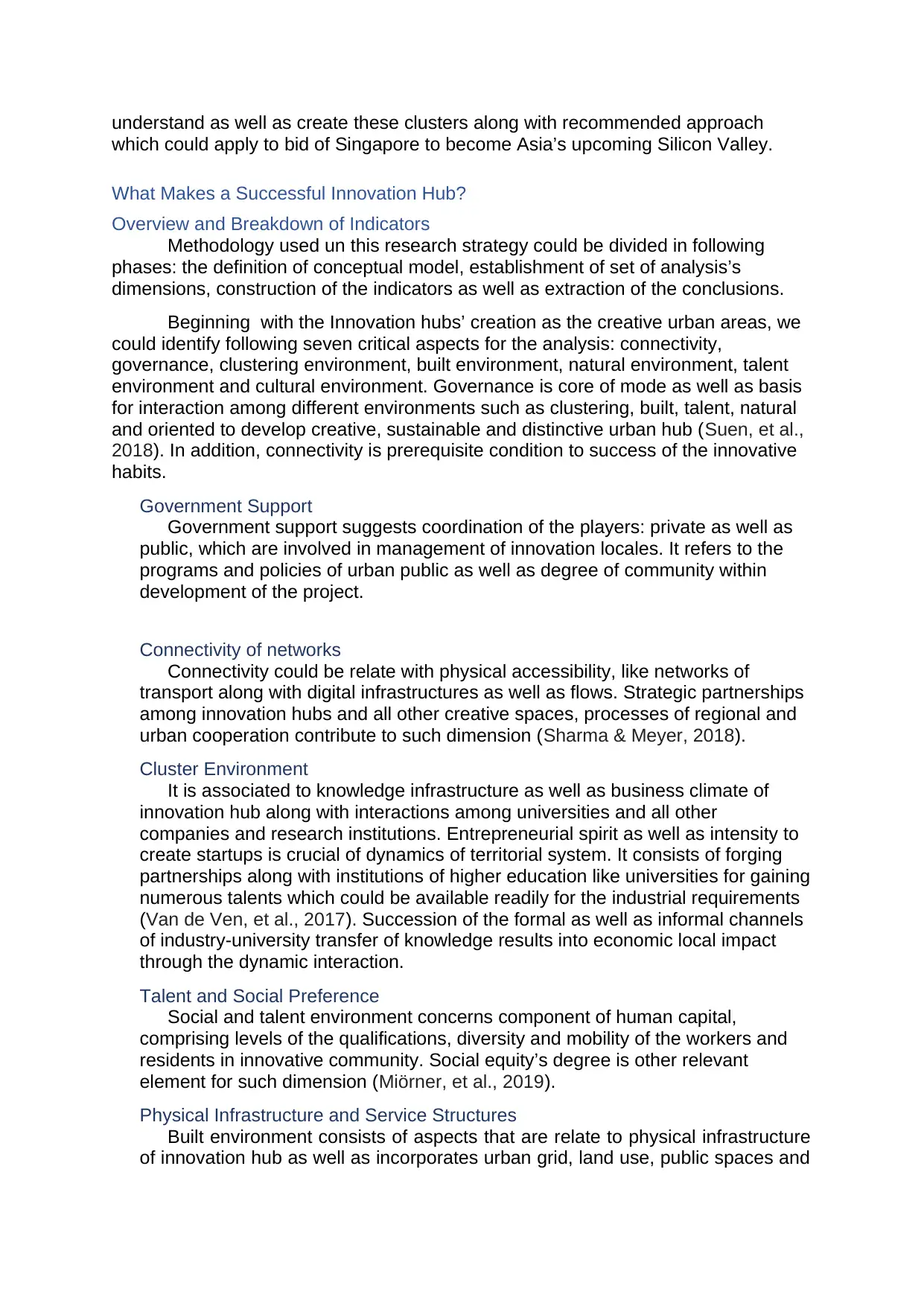
understand as well as create these clusters along with recommended approach
which could apply to bid of Singapore to become Asia’s upcoming Silicon Valley.
What Makes a Successful Innovation Hub?
Overview and Breakdown of Indicators
Methodology used un this research strategy could be divided in following
phases: the definition of conceptual model, establishment of set of analysis’s
dimensions, construction of the indicators as well as extraction of the conclusions.
Beginning with the Innovation hubs’ creation as the creative urban areas, we
could identify following seven critical aspects for the analysis: connectivity,
governance, clustering environment, built environment, natural environment, talent
environment and cultural environment. Governance is core of mode as well as basis
for interaction among different environments such as clustering, built, talent, natural
and oriented to develop creative, sustainable and distinctive urban hub (Suen, et al.,
2018). In addition, connectivity is prerequisite condition to success of the innovative
habits.
Government Support
Government support suggests coordination of the players: private as well as
public, which are involved in management of innovation locales. It refers to the
programs and policies of urban public as well as degree of community within
development of the project.
Connectivity of networks
Connectivity could be relate with physical accessibility, like networks of
transport along with digital infrastructures as well as flows. Strategic partnerships
among innovation hubs and all other creative spaces, processes of regional and
urban cooperation contribute to such dimension (Sharma & Meyer, 2018).
Cluster Environment
It is associated to knowledge infrastructure as well as business climate of
innovation hub along with interactions among universities and all other
companies and research institutions. Entrepreneurial spirit as well as intensity to
create startups is crucial of dynamics of territorial system. It consists of forging
partnerships along with institutions of higher education like universities for gaining
numerous talents which could be available readily for the industrial requirements
(Van de Ven, et al., 2017). Succession of the formal as well as informal channels
of industry-university transfer of knowledge results into economic local impact
through the dynamic interaction.
Talent and Social Preference
Social and talent environment concerns component of human capital,
comprising levels of the qualifications, diversity and mobility of the workers and
residents in innovative community. Social equity’s degree is other relevant
element for such dimension (Miörner, et al., 2019).
Physical Infrastructure and Service Structures
Built environment consists of aspects that are relate to physical infrastructure
of innovation hub as well as incorporates urban grid, land use, public spaces and
which could apply to bid of Singapore to become Asia’s upcoming Silicon Valley.
What Makes a Successful Innovation Hub?
Overview and Breakdown of Indicators
Methodology used un this research strategy could be divided in following
phases: the definition of conceptual model, establishment of set of analysis’s
dimensions, construction of the indicators as well as extraction of the conclusions.
Beginning with the Innovation hubs’ creation as the creative urban areas, we
could identify following seven critical aspects for the analysis: connectivity,
governance, clustering environment, built environment, natural environment, talent
environment and cultural environment. Governance is core of mode as well as basis
for interaction among different environments such as clustering, built, talent, natural
and oriented to develop creative, sustainable and distinctive urban hub (Suen, et al.,
2018). In addition, connectivity is prerequisite condition to success of the innovative
habits.
Government Support
Government support suggests coordination of the players: private as well as
public, which are involved in management of innovation locales. It refers to the
programs and policies of urban public as well as degree of community within
development of the project.
Connectivity of networks
Connectivity could be relate with physical accessibility, like networks of
transport along with digital infrastructures as well as flows. Strategic partnerships
among innovation hubs and all other creative spaces, processes of regional and
urban cooperation contribute to such dimension (Sharma & Meyer, 2018).
Cluster Environment
It is associated to knowledge infrastructure as well as business climate of
innovation hub along with interactions among universities and all other
companies and research institutions. Entrepreneurial spirit as well as intensity to
create startups is crucial of dynamics of territorial system. It consists of forging
partnerships along with institutions of higher education like universities for gaining
numerous talents which could be available readily for the industrial requirements
(Van de Ven, et al., 2017). Succession of the formal as well as informal channels
of industry-university transfer of knowledge results into economic local impact
through the dynamic interaction.
Talent and Social Preference
Social and talent environment concerns component of human capital,
comprising levels of the qualifications, diversity and mobility of the workers and
residents in innovative community. Social equity’s degree is other relevant
element for such dimension (Miörner, et al., 2019).
Physical Infrastructure and Service Structures
Built environment consists of aspects that are relate to physical infrastructure
of innovation hub as well as incorporates urban grid, land use, public spaces and
Secure Best Marks with AI Grader
Need help grading? Try our AI Grader for instant feedback on your assignments.
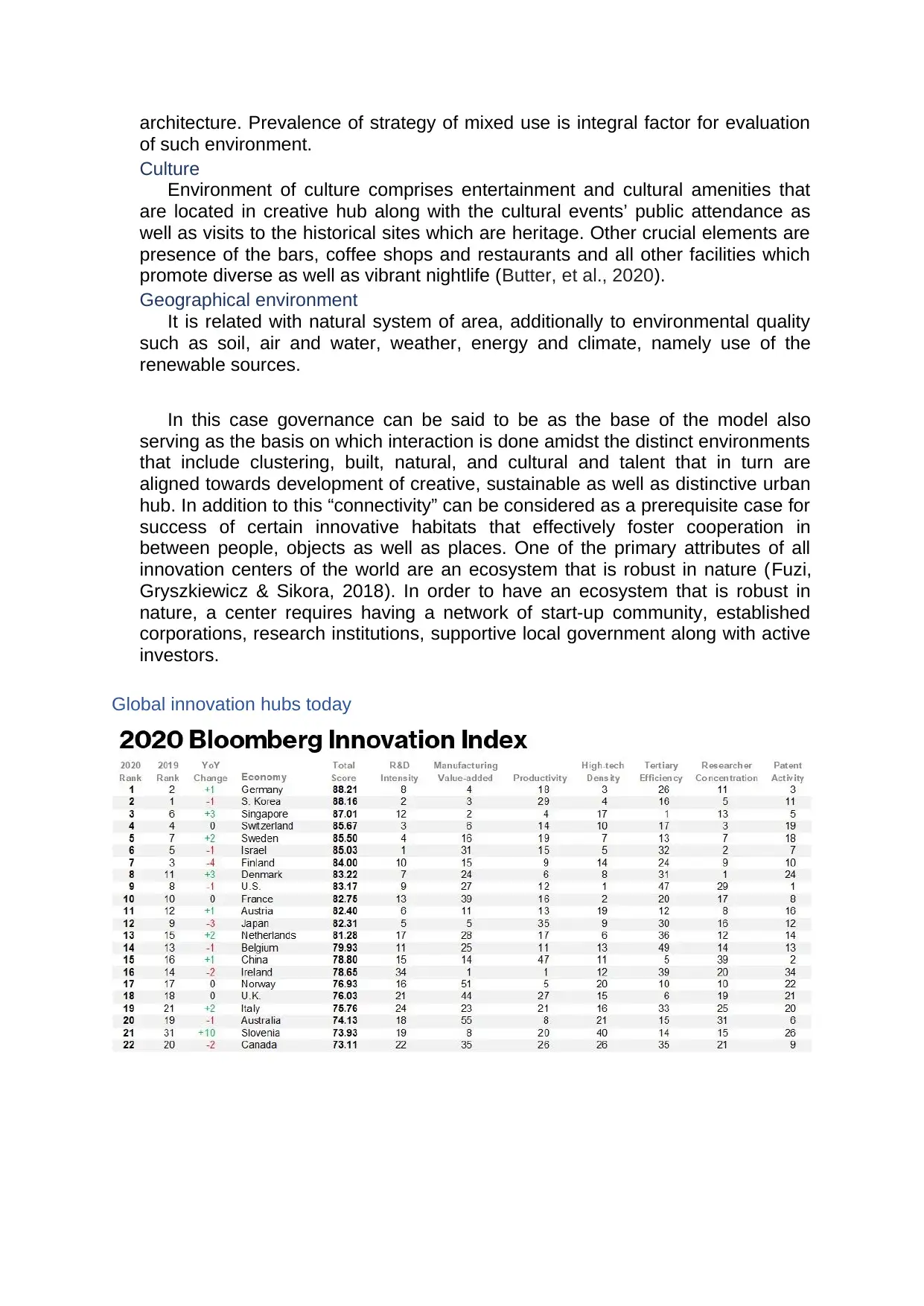
architecture. Prevalence of strategy of mixed use is integral factor for evaluation
of such environment.
Culture
Environment of culture comprises entertainment and cultural amenities that
are located in creative hub along with the cultural events’ public attendance as
well as visits to the historical sites which are heritage. Other crucial elements are
presence of the bars, coffee shops and restaurants and all other facilities which
promote diverse as well as vibrant nightlife (Butter, et al., 2020).
Geographical environment
It is related with natural system of area, additionally to environmental quality
such as soil, air and water, weather, energy and climate, namely use of the
renewable sources.
In this case governance can be said to be as the base of the model also
serving as the basis on which interaction is done amidst the distinct environments
that include clustering, built, natural, and cultural and talent that in turn are
aligned towards development of creative, sustainable as well as distinctive urban
hub. In addition to this “connectivity” can be considered as a prerequisite case for
success of certain innovative habitats that effectively foster cooperation in
between people, objects as well as places. One of the primary attributes of all
innovation centers of the world are an ecosystem that is robust in nature (Fuzi,
Gryszkiewicz & Sikora, 2018). In order to have an ecosystem that is robust in
nature, a center requires having a network of start-up community, established
corporations, research institutions, supportive local government along with active
investors.
Global innovation hubs today
of such environment.
Culture
Environment of culture comprises entertainment and cultural amenities that
are located in creative hub along with the cultural events’ public attendance as
well as visits to the historical sites which are heritage. Other crucial elements are
presence of the bars, coffee shops and restaurants and all other facilities which
promote diverse as well as vibrant nightlife (Butter, et al., 2020).
Geographical environment
It is related with natural system of area, additionally to environmental quality
such as soil, air and water, weather, energy and climate, namely use of the
renewable sources.
In this case governance can be said to be as the base of the model also
serving as the basis on which interaction is done amidst the distinct environments
that include clustering, built, natural, and cultural and talent that in turn are
aligned towards development of creative, sustainable as well as distinctive urban
hub. In addition to this “connectivity” can be considered as a prerequisite case for
success of certain innovative habitats that effectively foster cooperation in
between people, objects as well as places. One of the primary attributes of all
innovation centers of the world are an ecosystem that is robust in nature (Fuzi,
Gryszkiewicz & Sikora, 2018). In order to have an ecosystem that is robust in
nature, a center requires having a network of start-up community, established
corporations, research institutions, supportive local government along with active
investors.
Global innovation hubs today
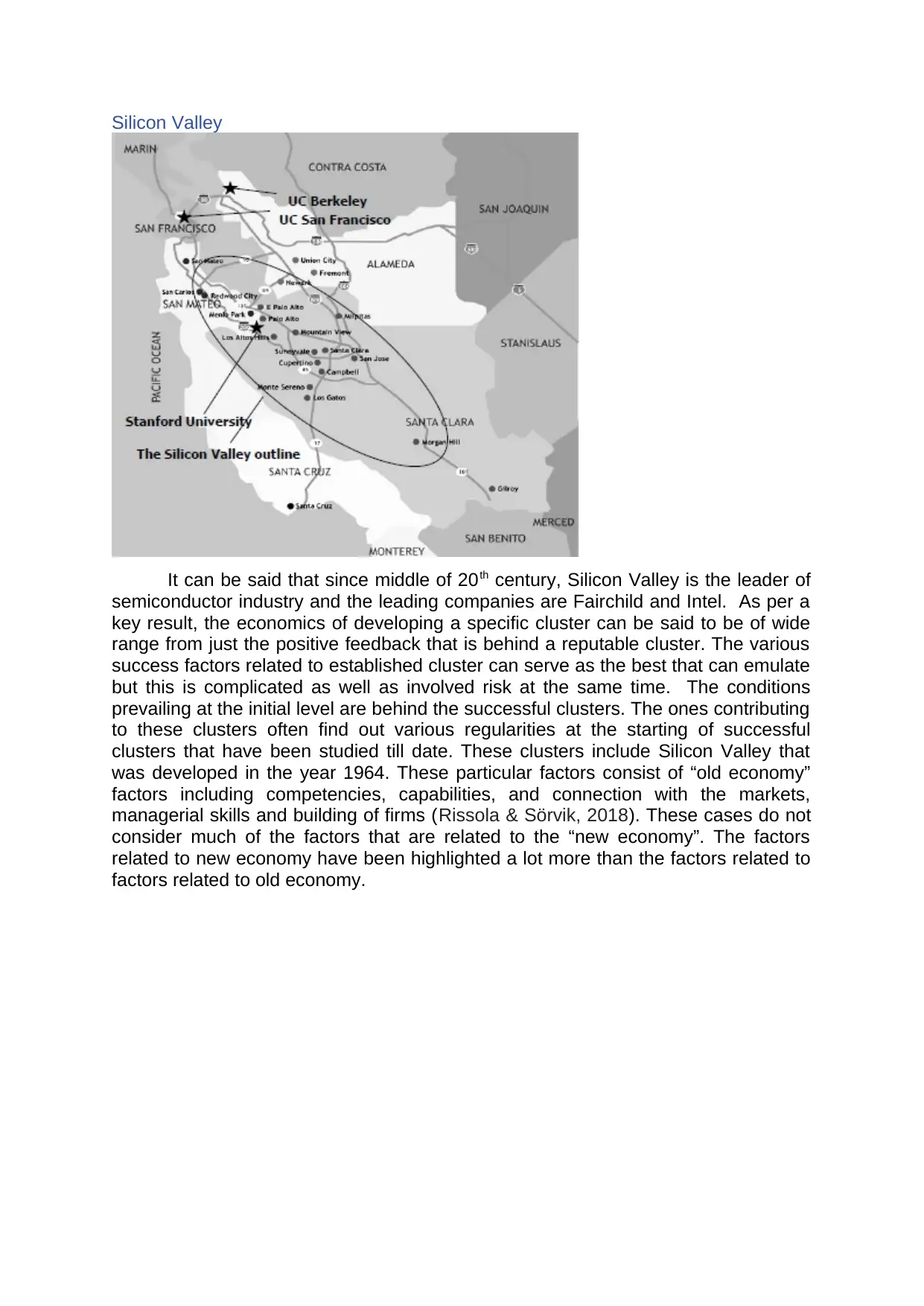
Silicon Valley
It can be said that since middle of 20th century, Silicon Valley is the leader of
semiconductor industry and the leading companies are Fairchild and Intel. As per a
key result, the economics of developing a specific cluster can be said to be of wide
range from just the positive feedback that is behind a reputable cluster. The various
success factors related to established cluster can serve as the best that can emulate
but this is complicated as well as involved risk at the same time. The conditions
prevailing at the initial level are behind the successful clusters. The ones contributing
to these clusters often find out various regularities at the starting of successful
clusters that have been studied till date. These clusters include Silicon Valley that
was developed in the year 1964. These particular factors consist of “old economy”
factors including competencies, capabilities, and connection with the markets,
managerial skills and building of firms (Rissola & Sörvik, 2018). These cases do not
consider much of the factors that are related to the “new economy”. The factors
related to new economy have been highlighted a lot more than the factors related to
factors related to old economy.
It can be said that since middle of 20th century, Silicon Valley is the leader of
semiconductor industry and the leading companies are Fairchild and Intel. As per a
key result, the economics of developing a specific cluster can be said to be of wide
range from just the positive feedback that is behind a reputable cluster. The various
success factors related to established cluster can serve as the best that can emulate
but this is complicated as well as involved risk at the same time. The conditions
prevailing at the initial level are behind the successful clusters. The ones contributing
to these clusters often find out various regularities at the starting of successful
clusters that have been studied till date. These clusters include Silicon Valley that
was developed in the year 1964. These particular factors consist of “old economy”
factors including competencies, capabilities, and connection with the markets,
managerial skills and building of firms (Rissola & Sörvik, 2018). These cases do not
consider much of the factors that are related to the “new economy”. The factors
related to new economy have been highlighted a lot more than the factors related to
factors related to old economy.
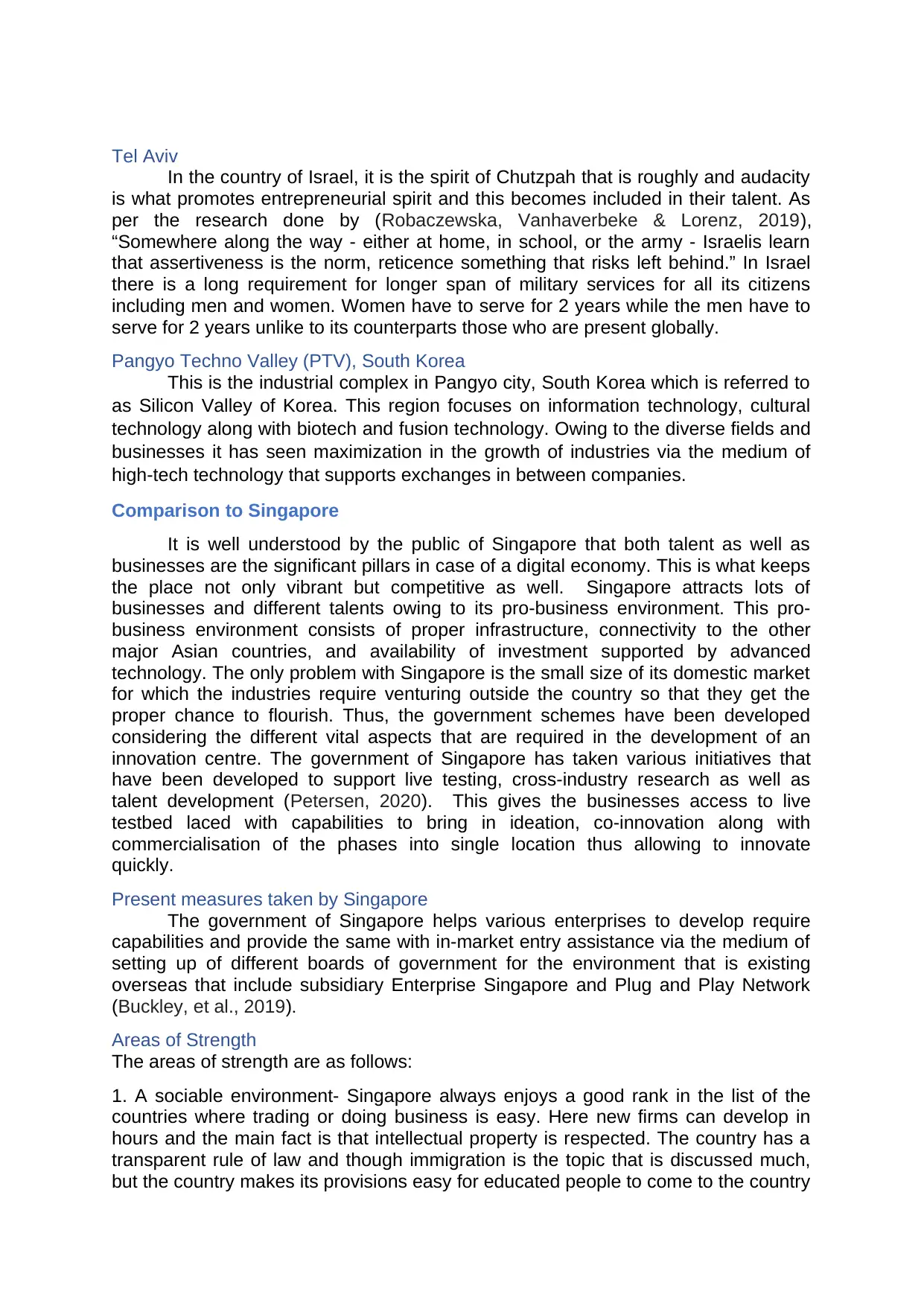
Tel Aviv
In the country of Israel, it is the spirit of Chutzpah that is roughly and audacity
is what promotes entrepreneurial spirit and this becomes included in their talent. As
per the research done by (Robaczewska, Vanhaverbeke & Lorenz, 2019),
“Somewhere along the way - either at home, in school, or the army - Israelis learn
that assertiveness is the norm, reticence something that risks left behind.” In Israel
there is a long requirement for longer span of military services for all its citizens
including men and women. Women have to serve for 2 years while the men have to
serve for 2 years unlike to its counterparts those who are present globally.
Pangyo Techno Valley (PTV), South Korea
This is the industrial complex in Pangyo city, South Korea which is referred to
as Silicon Valley of Korea. This region focuses on information technology, cultural
technology along with biotech and fusion technology. Owing to the diverse fields and
businesses it has seen maximization in the growth of industries via the medium of
high-tech technology that supports exchanges in between companies.
Comparison to Singapore
It is well understood by the public of Singapore that both talent as well as
businesses are the significant pillars in case of a digital economy. This is what keeps
the place not only vibrant but competitive as well. Singapore attracts lots of
businesses and different talents owing to its pro-business environment. This pro-
business environment consists of proper infrastructure, connectivity to the other
major Asian countries, and availability of investment supported by advanced
technology. The only problem with Singapore is the small size of its domestic market
for which the industries require venturing outside the country so that they get the
proper chance to flourish. Thus, the government schemes have been developed
considering the different vital aspects that are required in the development of an
innovation centre. The government of Singapore has taken various initiatives that
have been developed to support live testing, cross-industry research as well as
talent development (Petersen, 2020). This gives the businesses access to live
testbed laced with capabilities to bring in ideation, co-innovation along with
commercialisation of the phases into single location thus allowing to innovate
quickly.
Present measures taken by Singapore
The government of Singapore helps various enterprises to develop require
capabilities and provide the same with in-market entry assistance via the medium of
setting up of different boards of government for the environment that is existing
overseas that include subsidiary Enterprise Singapore and Plug and Play Network
(Buckley, et al., 2019).
Areas of Strength
The areas of strength are as follows:
1. A sociable environment- Singapore always enjoys a good rank in the list of the
countries where trading or doing business is easy. Here new firms can develop in
hours and the main fact is that intellectual property is respected. The country has a
transparent rule of law and though immigration is the topic that is discussed much,
but the country makes its provisions easy for educated people to come to the country
In the country of Israel, it is the spirit of Chutzpah that is roughly and audacity
is what promotes entrepreneurial spirit and this becomes included in their talent. As
per the research done by (Robaczewska, Vanhaverbeke & Lorenz, 2019),
“Somewhere along the way - either at home, in school, or the army - Israelis learn
that assertiveness is the norm, reticence something that risks left behind.” In Israel
there is a long requirement for longer span of military services for all its citizens
including men and women. Women have to serve for 2 years while the men have to
serve for 2 years unlike to its counterparts those who are present globally.
Pangyo Techno Valley (PTV), South Korea
This is the industrial complex in Pangyo city, South Korea which is referred to
as Silicon Valley of Korea. This region focuses on information technology, cultural
technology along with biotech and fusion technology. Owing to the diverse fields and
businesses it has seen maximization in the growth of industries via the medium of
high-tech technology that supports exchanges in between companies.
Comparison to Singapore
It is well understood by the public of Singapore that both talent as well as
businesses are the significant pillars in case of a digital economy. This is what keeps
the place not only vibrant but competitive as well. Singapore attracts lots of
businesses and different talents owing to its pro-business environment. This pro-
business environment consists of proper infrastructure, connectivity to the other
major Asian countries, and availability of investment supported by advanced
technology. The only problem with Singapore is the small size of its domestic market
for which the industries require venturing outside the country so that they get the
proper chance to flourish. Thus, the government schemes have been developed
considering the different vital aspects that are required in the development of an
innovation centre. The government of Singapore has taken various initiatives that
have been developed to support live testing, cross-industry research as well as
talent development (Petersen, 2020). This gives the businesses access to live
testbed laced with capabilities to bring in ideation, co-innovation along with
commercialisation of the phases into single location thus allowing to innovate
quickly.
Present measures taken by Singapore
The government of Singapore helps various enterprises to develop require
capabilities and provide the same with in-market entry assistance via the medium of
setting up of different boards of government for the environment that is existing
overseas that include subsidiary Enterprise Singapore and Plug and Play Network
(Buckley, et al., 2019).
Areas of Strength
The areas of strength are as follows:
1. A sociable environment- Singapore always enjoys a good rank in the list of the
countries where trading or doing business is easy. Here new firms can develop in
hours and the main fact is that intellectual property is respected. The country has a
transparent rule of law and though immigration is the topic that is discussed much,
but the country makes its provisions easy for educated people to come to the country
Paraphrase This Document
Need a fresh take? Get an instant paraphrase of this document with our AI Paraphraser
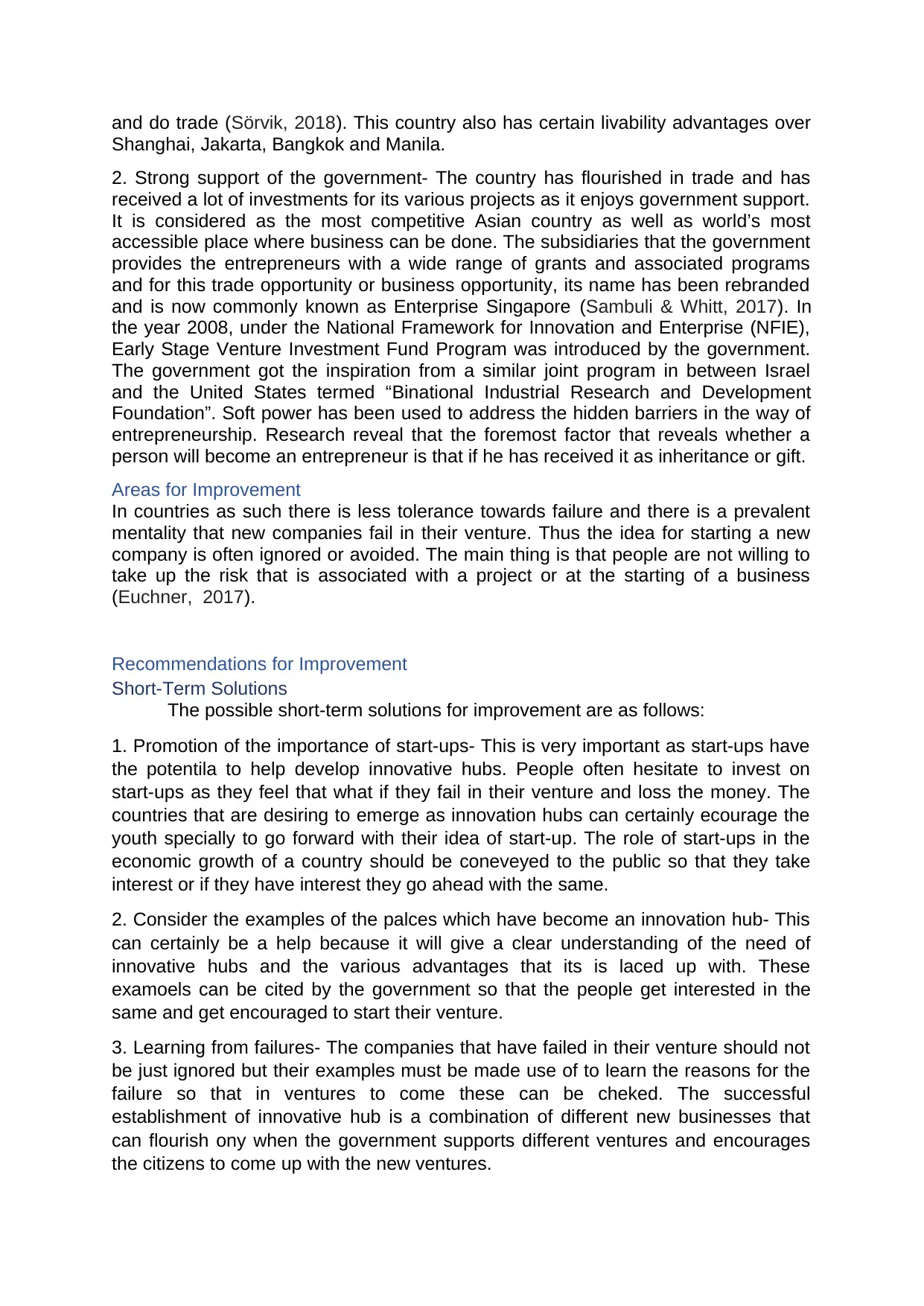
and do trade (Sörvik, 2018). This country also has certain livability advantages over
Shanghai, Jakarta, Bangkok and Manila.
2. Strong support of the government- The country has flourished in trade and has
received a lot of investments for its various projects as it enjoys government support.
It is considered as the most competitive Asian country as well as world’s most
accessible place where business can be done. The subsidiaries that the government
provides the entrepreneurs with a wide range of grants and associated programs
and for this trade opportunity or business opportunity, its name has been rebranded
and is now commonly known as Enterprise Singapore (Sambuli & Whitt, 2017). In
the year 2008, under the National Framework for Innovation and Enterprise (NFIE),
Early Stage Venture Investment Fund Program was introduced by the government.
The government got the inspiration from a similar joint program in between Israel
and the United States termed “Binational Industrial Research and Development
Foundation”. Soft power has been used to address the hidden barriers in the way of
entrepreneurship. Research reveal that the foremost factor that reveals whether a
person will become an entrepreneur is that if he has received it as inheritance or gift.
Areas for Improvement
In countries as such there is less tolerance towards failure and there is a prevalent
mentality that new companies fail in their venture. Thus the idea for starting a new
company is often ignored or avoided. The main thing is that people are not willing to
take up the risk that is associated with a project or at the starting of a business
(Euchner, 2017).
Recommendations for Improvement
Short-Term Solutions
The possible short-term solutions for improvement are as follows:
1. Promotion of the importance of start-ups- This is very important as start-ups have
the potentila to help develop innovative hubs. People often hesitate to invest on
start-ups as they feel that what if they fail in their venture and loss the money. The
countries that are desiring to emerge as innovation hubs can certainly ecourage the
youth specially to go forward with their idea of start-up. The role of start-ups in the
economic growth of a country should be coneveyed to the public so that they take
interest or if they have interest they go ahead with the same.
2. Consider the examples of the palces which have become an innovation hub- This
can certainly be a help because it will give a clear understanding of the need of
innovative hubs and the various advantages that its is laced up with. These
examoels can be cited by the government so that the people get interested in the
same and get encouraged to start their venture.
3. Learning from failures- The companies that have failed in their venture should not
be just ignored but their examples must be made use of to learn the reasons for the
failure so that in ventures to come these can be cheked. The successful
establishment of innovative hub is a combination of different new businesses that
can flourish ony when the government supports different ventures and encourages
the citizens to come up with the new ventures.
Shanghai, Jakarta, Bangkok and Manila.
2. Strong support of the government- The country has flourished in trade and has
received a lot of investments for its various projects as it enjoys government support.
It is considered as the most competitive Asian country as well as world’s most
accessible place where business can be done. The subsidiaries that the government
provides the entrepreneurs with a wide range of grants and associated programs
and for this trade opportunity or business opportunity, its name has been rebranded
and is now commonly known as Enterprise Singapore (Sambuli & Whitt, 2017). In
the year 2008, under the National Framework for Innovation and Enterprise (NFIE),
Early Stage Venture Investment Fund Program was introduced by the government.
The government got the inspiration from a similar joint program in between Israel
and the United States termed “Binational Industrial Research and Development
Foundation”. Soft power has been used to address the hidden barriers in the way of
entrepreneurship. Research reveal that the foremost factor that reveals whether a
person will become an entrepreneur is that if he has received it as inheritance or gift.
Areas for Improvement
In countries as such there is less tolerance towards failure and there is a prevalent
mentality that new companies fail in their venture. Thus the idea for starting a new
company is often ignored or avoided. The main thing is that people are not willing to
take up the risk that is associated with a project or at the starting of a business
(Euchner, 2017).
Recommendations for Improvement
Short-Term Solutions
The possible short-term solutions for improvement are as follows:
1. Promotion of the importance of start-ups- This is very important as start-ups have
the potentila to help develop innovative hubs. People often hesitate to invest on
start-ups as they feel that what if they fail in their venture and loss the money. The
countries that are desiring to emerge as innovation hubs can certainly ecourage the
youth specially to go forward with their idea of start-up. The role of start-ups in the
economic growth of a country should be coneveyed to the public so that they take
interest or if they have interest they go ahead with the same.
2. Consider the examples of the palces which have become an innovation hub- This
can certainly be a help because it will give a clear understanding of the need of
innovative hubs and the various advantages that its is laced up with. These
examoels can be cited by the government so that the people get interested in the
same and get encouraged to start their venture.
3. Learning from failures- The companies that have failed in their venture should not
be just ignored but their examples must be made use of to learn the reasons for the
failure so that in ventures to come these can be cheked. The successful
establishment of innovative hub is a combination of different new businesses that
can flourish ony when the government supports different ventures and encourages
the citizens to come up with the new ventures.
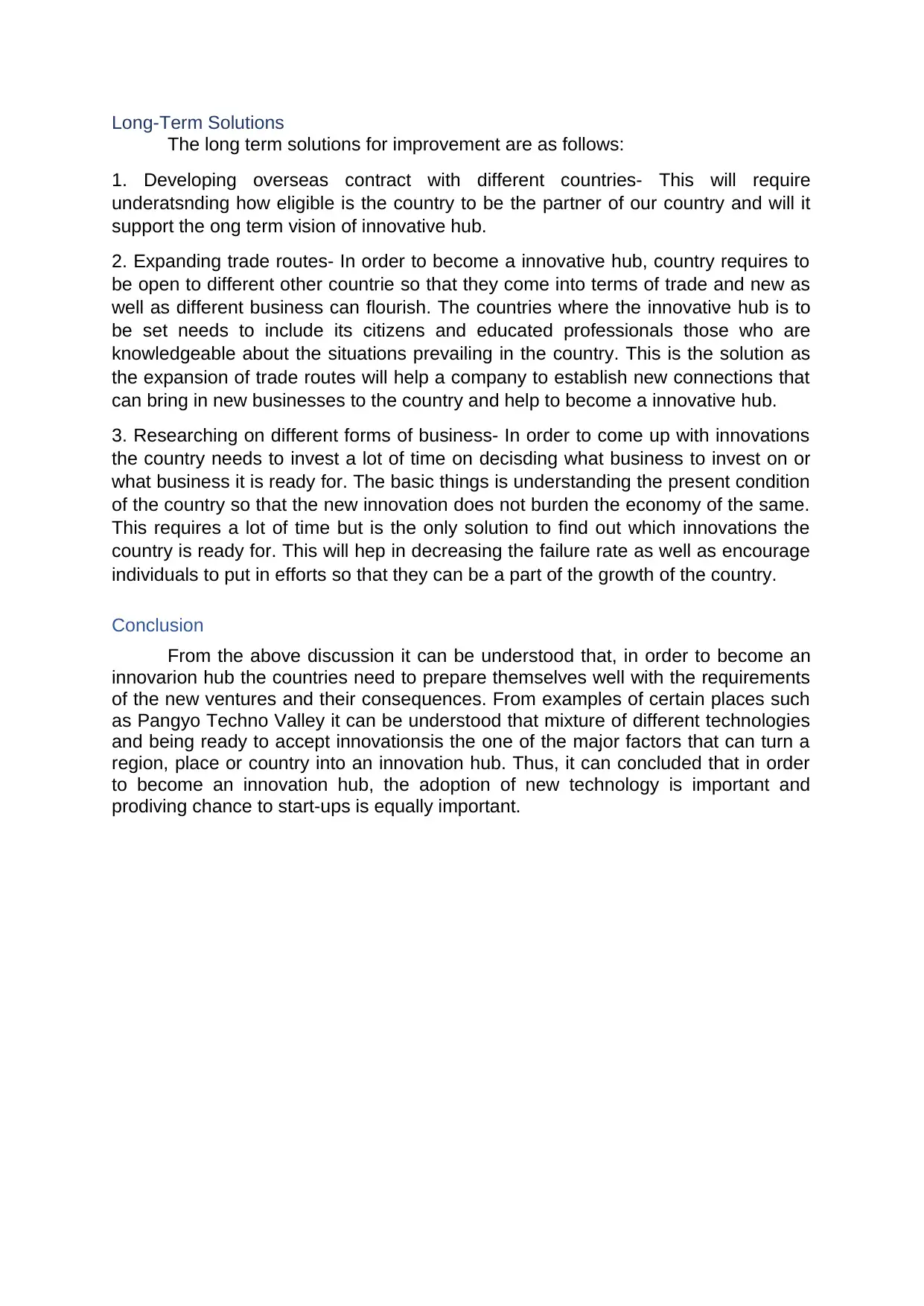
Long-Term Solutions
The long term solutions for improvement are as follows:
1. Developing overseas contract with different countries- This will require
underatsnding how eligible is the country to be the partner of our country and will it
support the ong term vision of innovative hub.
2. Expanding trade routes- In order to become a innovative hub, country requires to
be open to different other countrie so that they come into terms of trade and new as
well as different business can flourish. The countries where the innovative hub is to
be set needs to include its citizens and educated professionals those who are
knowledgeable about the situations prevailing in the country. This is the solution as
the expansion of trade routes will help a company to establish new connections that
can bring in new businesses to the country and help to become a innovative hub.
3. Researching on different forms of business- In order to come up with innovations
the country needs to invest a lot of time on decisding what business to invest on or
what business it is ready for. The basic things is understanding the present condition
of the country so that the new innovation does not burden the economy of the same.
This requires a lot of time but is the only solution to find out which innovations the
country is ready for. This will hep in decreasing the failure rate as well as encourage
individuals to put in efforts so that they can be a part of the growth of the country.
Conclusion
From the above discussion it can be understood that, in order to become an
innovarion hub the countries need to prepare themselves well with the requirements
of the new ventures and their consequences. From examples of certain places such
as Pangyo Techno Valley it can be understood that mixture of different technologies
and being ready to accept innovationsis the one of the major factors that can turn a
region, place or country into an innovation hub. Thus, it can concluded that in order
to become an innovation hub, the adoption of new technology is important and
prodiving chance to start-ups is equally important.
The long term solutions for improvement are as follows:
1. Developing overseas contract with different countries- This will require
underatsnding how eligible is the country to be the partner of our country and will it
support the ong term vision of innovative hub.
2. Expanding trade routes- In order to become a innovative hub, country requires to
be open to different other countrie so that they come into terms of trade and new as
well as different business can flourish. The countries where the innovative hub is to
be set needs to include its citizens and educated professionals those who are
knowledgeable about the situations prevailing in the country. This is the solution as
the expansion of trade routes will help a company to establish new connections that
can bring in new businesses to the country and help to become a innovative hub.
3. Researching on different forms of business- In order to come up with innovations
the country needs to invest a lot of time on decisding what business to invest on or
what business it is ready for. The basic things is understanding the present condition
of the country so that the new innovation does not burden the economy of the same.
This requires a lot of time but is the only solution to find out which innovations the
country is ready for. This will hep in decreasing the failure rate as well as encourage
individuals to put in efforts so that they can be a part of the growth of the country.
Conclusion
From the above discussion it can be understood that, in order to become an
innovarion hub the countries need to prepare themselves well with the requirements
of the new ventures and their consequences. From examples of certain places such
as Pangyo Techno Valley it can be understood that mixture of different technologies
and being ready to accept innovationsis the one of the major factors that can turn a
region, place or country into an innovation hub. Thus, it can concluded that in order
to become an innovation hub, the adoption of new technology is important and
prodiving chance to start-ups is equally important.
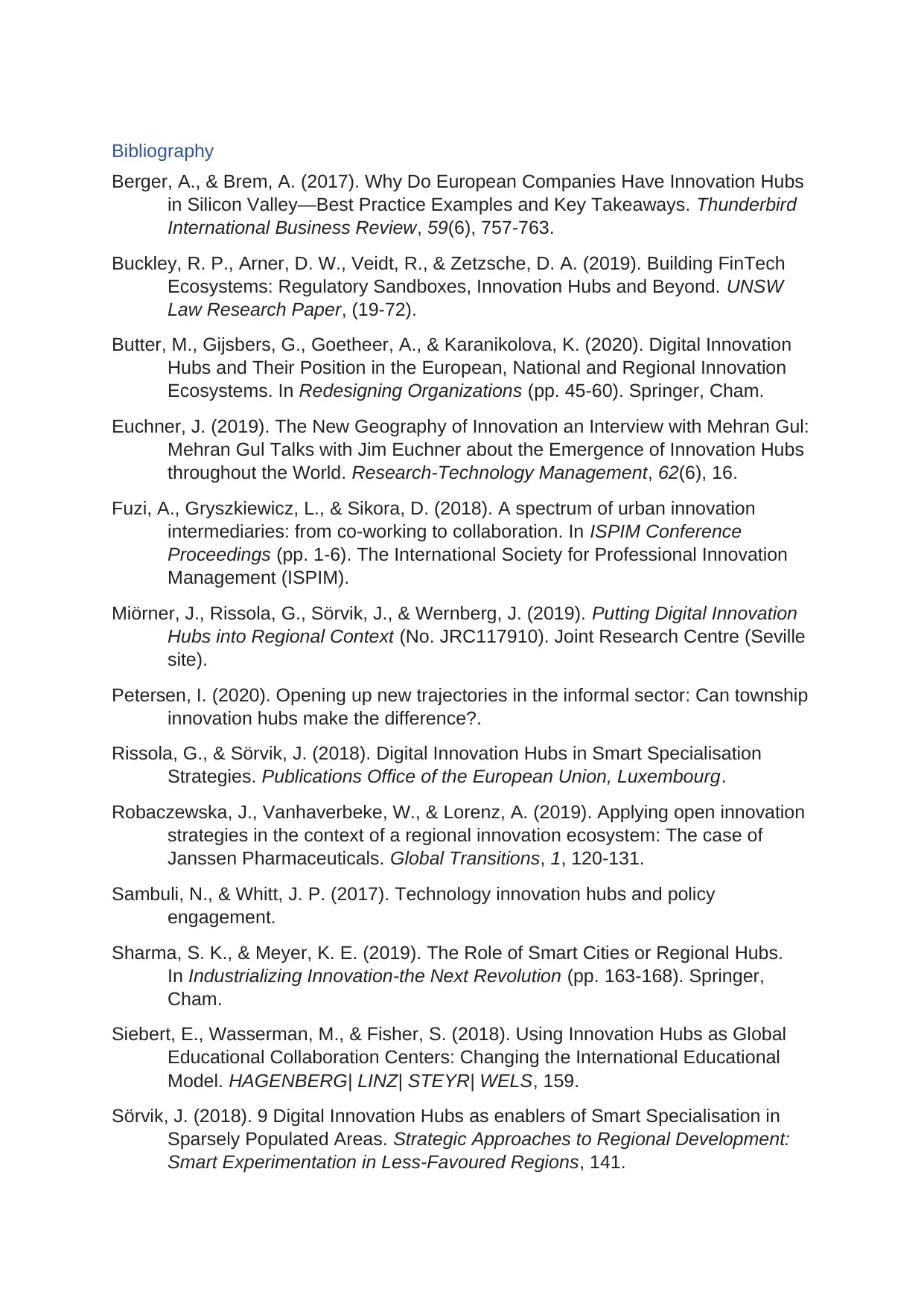
Bibliography
Berger, A., & Brem, A. (2017). Why Do European Companies Have Innovation Hubs
in Silicon Valley—Best Practice Examples and Key Takeaways. Thunderbird
International Business Review, 59(6), 757-763.
Buckley, R. P., Arner, D. W., Veidt, R., & Zetzsche, D. A. (2019). Building FinTech
Ecosystems: Regulatory Sandboxes, Innovation Hubs and Beyond. UNSW
Law Research Paper, (19-72).
Butter, M., Gijsbers, G., Goetheer, A., & Karanikolova, K. (2020). Digital Innovation
Hubs and Their Position in the European, National and Regional Innovation
Ecosystems. In Redesigning Organizations (pp. 45-60). Springer, Cham.
Euchner, J. (2019). The New Geography of Innovation an Interview with Mehran Gul:
Mehran Gul Talks with Jim Euchner about the Emergence of Innovation Hubs
throughout the World. Research-Technology Management, 62(6), 16.
Fuzi, A., Gryszkiewicz, L., & Sikora, D. (2018). A spectrum of urban innovation
intermediaries: from co-working to collaboration. In ISPIM Conference
Proceedings (pp. 1-6). The International Society for Professional Innovation
Management (ISPIM).
Miörner, J., Rissola, G., Sörvik, J., & Wernberg, J. (2019). Putting Digital Innovation
Hubs into Regional Context (No. JRC117910). Joint Research Centre (Seville
site).
Petersen, I. (2020). Opening up new trajectories in the informal sector: Can township
innovation hubs make the difference?.
Rissola, G., & Sörvik, J. (2018). Digital Innovation Hubs in Smart Specialisation
Strategies. Publications Office of the European Union, Luxembourg.
Robaczewska, J., Vanhaverbeke, W., & Lorenz, A. (2019). Applying open innovation
strategies in the context of a regional innovation ecosystem: The case of
Janssen Pharmaceuticals. Global Transitions, 1, 120-131.
Sambuli, N., & Whitt, J. P. (2017). Technology innovation hubs and policy
engagement.
Sharma, S. K., & Meyer, K. E. (2019). The Role of Smart Cities or Regional Hubs.
In Industrializing Innovation-the Next Revolution (pp. 163-168). Springer,
Cham.
Siebert, E., Wasserman, M., & Fisher, S. (2018). Using Innovation Hubs as Global
Educational Collaboration Centers: Changing the International Educational
Model. HAGENBERG| LINZ| STEYR| WELS, 159.
Sörvik, J. (2018). 9 Digital Innovation Hubs as enablers of Smart Specialisation in
Sparsely Populated Areas. Strategic Approaches to Regional Development:
Smart Experimentation in Less-Favoured Regions, 141.
Berger, A., & Brem, A. (2017). Why Do European Companies Have Innovation Hubs
in Silicon Valley—Best Practice Examples and Key Takeaways. Thunderbird
International Business Review, 59(6), 757-763.
Buckley, R. P., Arner, D. W., Veidt, R., & Zetzsche, D. A. (2019). Building FinTech
Ecosystems: Regulatory Sandboxes, Innovation Hubs and Beyond. UNSW
Law Research Paper, (19-72).
Butter, M., Gijsbers, G., Goetheer, A., & Karanikolova, K. (2020). Digital Innovation
Hubs and Their Position in the European, National and Regional Innovation
Ecosystems. In Redesigning Organizations (pp. 45-60). Springer, Cham.
Euchner, J. (2019). The New Geography of Innovation an Interview with Mehran Gul:
Mehran Gul Talks with Jim Euchner about the Emergence of Innovation Hubs
throughout the World. Research-Technology Management, 62(6), 16.
Fuzi, A., Gryszkiewicz, L., & Sikora, D. (2018). A spectrum of urban innovation
intermediaries: from co-working to collaboration. In ISPIM Conference
Proceedings (pp. 1-6). The International Society for Professional Innovation
Management (ISPIM).
Miörner, J., Rissola, G., Sörvik, J., & Wernberg, J. (2019). Putting Digital Innovation
Hubs into Regional Context (No. JRC117910). Joint Research Centre (Seville
site).
Petersen, I. (2020). Opening up new trajectories in the informal sector: Can township
innovation hubs make the difference?.
Rissola, G., & Sörvik, J. (2018). Digital Innovation Hubs in Smart Specialisation
Strategies. Publications Office of the European Union, Luxembourg.
Robaczewska, J., Vanhaverbeke, W., & Lorenz, A. (2019). Applying open innovation
strategies in the context of a regional innovation ecosystem: The case of
Janssen Pharmaceuticals. Global Transitions, 1, 120-131.
Sambuli, N., & Whitt, J. P. (2017). Technology innovation hubs and policy
engagement.
Sharma, S. K., & Meyer, K. E. (2019). The Role of Smart Cities or Regional Hubs.
In Industrializing Innovation-the Next Revolution (pp. 163-168). Springer,
Cham.
Siebert, E., Wasserman, M., & Fisher, S. (2018). Using Innovation Hubs as Global
Educational Collaboration Centers: Changing the International Educational
Model. HAGENBERG| LINZ| STEYR| WELS, 159.
Sörvik, J. (2018). 9 Digital Innovation Hubs as enablers of Smart Specialisation in
Sparsely Populated Areas. Strategic Approaches to Regional Development:
Smart Experimentation in Less-Favoured Regions, 141.
Secure Best Marks with AI Grader
Need help grading? Try our AI Grader for instant feedback on your assignments.
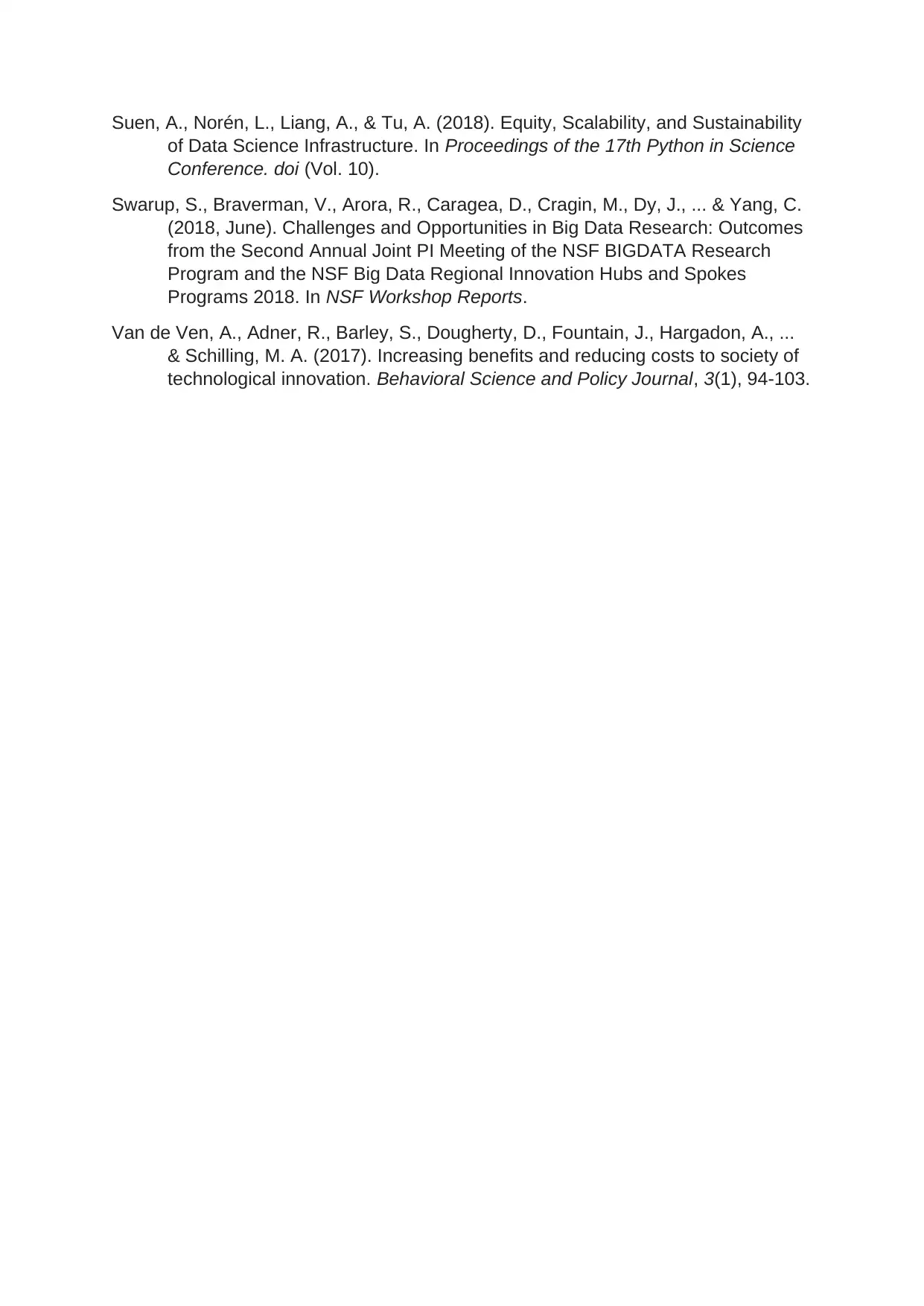
Suen, A., Norén, L., Liang, A., & Tu, A. (2018). Equity, Scalability, and Sustainability
of Data Science Infrastructure. In Proceedings of the 17th Python in Science
Conference. doi (Vol. 10).
Swarup, S., Braverman, V., Arora, R., Caragea, D., Cragin, M., Dy, J., ... & Yang, C.
(2018, June). Challenges and Opportunities in Big Data Research: Outcomes
from the Second Annual Joint PI Meeting of the NSF BIGDATA Research
Program and the NSF Big Data Regional Innovation Hubs and Spokes
Programs 2018. In NSF Workshop Reports.
Van de Ven, A., Adner, R., Barley, S., Dougherty, D., Fountain, J., Hargadon, A., ...
& Schilling, M. A. (2017). Increasing benefits and reducing costs to society of
technological innovation. Behavioral Science and Policy Journal, 3(1), 94-103.
of Data Science Infrastructure. In Proceedings of the 17th Python in Science
Conference. doi (Vol. 10).
Swarup, S., Braverman, V., Arora, R., Caragea, D., Cragin, M., Dy, J., ... & Yang, C.
(2018, June). Challenges and Opportunities in Big Data Research: Outcomes
from the Second Annual Joint PI Meeting of the NSF BIGDATA Research
Program and the NSF Big Data Regional Innovation Hubs and Spokes
Programs 2018. In NSF Workshop Reports.
Van de Ven, A., Adner, R., Barley, S., Dougherty, D., Fountain, J., Hargadon, A., ...
& Schilling, M. A. (2017). Increasing benefits and reducing costs to society of
technological innovation. Behavioral Science and Policy Journal, 3(1), 94-103.
1 out of 11
Your All-in-One AI-Powered Toolkit for Academic Success.
+13062052269
info@desklib.com
Available 24*7 on WhatsApp / Email
![[object Object]](/_next/static/media/star-bottom.7253800d.svg)
Unlock your academic potential
© 2024 | Zucol Services PVT LTD | All rights reserved.